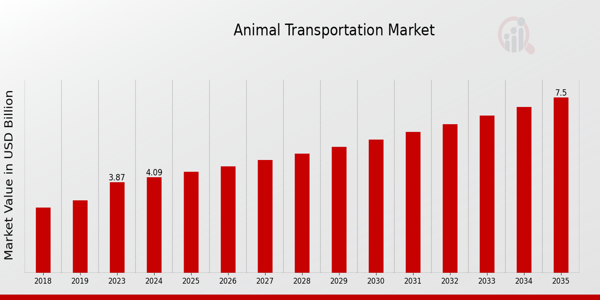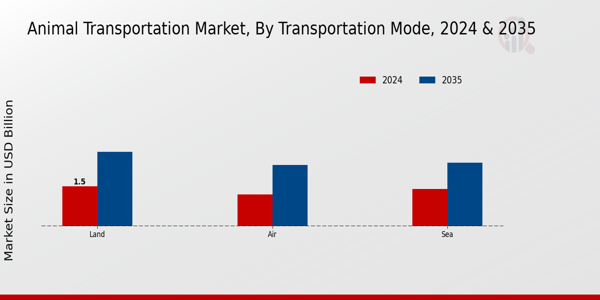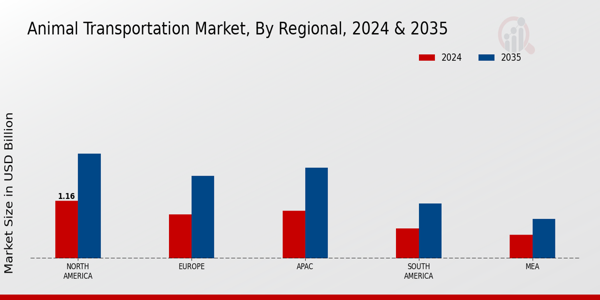Global Animal Transportation Market Overview
The Animal Transportation Market Size was estimated at 3.87 (USD Billion) in 2023. The Animal Transportation Industry is expected to grow from 4.09(USD Billion) in 2024 to 7.5 (USD Billion) by 2035. The Animal Transportation Market CAGR (growth rate) is expected to be around 5.68% during the forecast period (2025 - 2035).
Key Animal Transportation Market Trends Highlighted
The Animal Transportation Market is seeing a large number of market drivers which are changing the landscape of the market. One of the primary drivers is the growing trend of ization. Countries wanting to improve their food security and agricultural investments, there is a need for cross-border trade of livestock and animal products. Another important driver is pet population, resulting in pet relocation and transportation services. Also, development in transportation technologies, such as temperature-controlled containers and live animal handling have enhanced the safety and efficiency in animal transport, therefore increasing the appeal to businesses.
The market is open to a large number of possibilities that are yet to be tapped into. Greater concern for animal welfare during transportation is leading companies to implement improved measures. Technology milestones in tracking and monitoring can provide convenience to all parties during transportation. Consumers are increasingly looking for green solutions, hence sustainability is gaining traction. Businesses that are able to devise tailored and efficient means in which specific animals can be moved can also hold a large proportion of the market. Partnerships with veterinary bulks can provide enhanced services by ensuring that the animals are well taken care of before and during transportation.
Trends noted recently indicate that there is an increased emphasis on regulations on animal transportation. This is necessitated by the increasing focus on animal welfare, and the humane treatment of animals in transit. Furthermore, apple-to-apple e-commerce touch in pet sales has revolutionized the approach to the marketing and transportation of animals, giving rise to more direct shipping to consumers. Besides, there is a growing tendency to use digital solutions, which simplify logistics and make processes more efficient. All these factors are transforming the Animal Transportation Market, providing a changing environment for business opportunities.

Animal Transportation Market Drivers
Increasing Demand for Animal Products
The Animal Transportation Market Industry is experiencing significant growth driven by the rising demand for animal products, including meat, dairy, and eggs. As population growth accelerates and urbanization increases, there is a corresponding rise in the demand for high-quality animal protein across various regions. Consumer preferences are shifting towards more sustainable sources of protein, which necessitates the transportation of livestock, poultry, and other animals over long distances to meet market needs.This demand is particularly evident in emerging economies where income levels are rising, and consumers are increasingly including meat and dairy in their diets. With the market for animal products projected to expand significantly in the coming years, the transportation of live animals becomes a critical component of the supply chain. Efficient animal transportation ensures the timely delivery of healthy and safe animals, thus maintaining the quality and availability of animal products in the market.As companies strive to fulfill this increasing demand, the industry is seeing technological advancements that improve transportation methods, ensuring they are both safe for the animals and compliant with regulatory requirements. The necessity of transporting animals for breeding, slaughter, and trade purposes further underscores the importance of this market driver.
Advancements in Logistics and Transportation Technology
The Animal Transportation Market Industry is being propelled by advancements in logistics and transportation technology. Innovations such as temperature-controlled transportation, real-time tracking, and automated handling systems are enhancing the efficiency and safety of animal transportation. These technologies not only ensure that animals are transported in conditions that meet health and safety standards but also improve operational efficiency for transporters.Furthermore, the integration of data analytics helps in optimizing routes and minimizing transit times, which is crucial in maintaining the health and welfare of the animals during transportation. As these technologies continue to evolve, they are expected to further improve the capabilities of animal transport services, making them more reliable and accessible.
Regulatory Support and Animal Welfare Initiatives
Regulatory support and animal welfare initiatives are increasingly influencing the Animal Transportation Market Industry. Governments and international bodies have been tightening regulations surrounding the transportation of live animals to ensure their safety and welfare during transit. This focus on animal welfare has led to the development of standardized procedures and guidelines that transporters must follow, promoting the best practices across the industry.Organizations are also developing more comprehensive training programs to educate animal transport personnel on humane handling techniques. This trend ensures not only compliance with regulations but also aligns with consumer expectations for the ethical treatment of animals, thereby enhancing market growth.
Animal Transportation Market Segment Insights
Animal Transportation Market Transportation Mode Insights
The Animal Transportation Market is characterized by its varied transportation modes, consisting of Land, Air, and Sea. As of 2024, the Land transportation mode holds a significant valuation of 1.5 USD Billion, showcasing its importance in facilitating the movement of animals, especially domesticated ones, across various regions. With a projected rise to 2.8 USD Billion by 2035, this mode represents a substantial majority in market share, primarily due to the high frequency of land routes used for transporting livestock and pets. The Air segment, starting at a valuation of 1.2 USD Billion in 2024 and expected to grow to 2.3 USD Billion by 2035, plays a critical role in international transportation where the rapid transfer of animals is essential, particularly for exotic species or animals requiring urgent relocation as it dominates in speed and efficiency over long distances.The Sea transportation mode, valued at 1.4 USD Billion in 2024 and anticipating growth to 2.4 USD Billion in 2035, is also significant, primarily utilized for bulk transport of livestock and aquatic animals, capitalizing on cost-effectiveness for large shipments. Each of these transportation modes demonstrates their unique advantages and collectively contributes to the growth of the Animal Transportation Market. The increasing demand for animal products, combined with ization, has driven the need for efficient animal transport solutions, creating lucrative opportunities.However, challenges such as regulatory compliance and health risks during transit present potential hurdles for market players. Understanding the dynamics of Animal Transportation Market segmentation is essential for stakeholders looking to capitalize on growth trends and navigate this complex landscape efficiently.

Animal Transportation Market Animal Type Insights
The Animal Transportation Market, which was valued at 4.09 billion USD in 2024, encompasses various segments categorized by Animal Type, such as Livestock, Pets, Wildlife, and Laboratory Animals. Each segment plays a crucial role in shaping the market dynamics, with Livestock transportation being vital for agricultural economies and food supply chains. The demand for efficient and humane movement of pets has also surged, impacted by changing lifestyles and increasing pet ownership. Wildlife transportation remains important for conservation efforts and inter-zonal relocations, while Laboratory Animals are critical for scientific research, ensuring compliance with regulatory standards during their movement.These distinctions in the Animal Transportation Market segmentation highlight the unique requirements and market growth opportunities across different animal types, contributing to an estimated market value of 7.5 billion USD by 2035.
Animal Transportation Market Service Type Insights
The Animal Transportation Market is shaped significantly by its Service Type segment, which encompasses various vital services including transportation services, logistics services, and veterinary services. By 2024, the overall market is projected to reach a value of 4.09 billion USD, with the necessity for efficient service delivery becoming increasingly important. Transportation services play a crucial role as they directly ensure the safe and timely movement of animals, thus catering to the rising demand from pet owners and livestock sectors alike.Logistics services contribute greatly to the organization and management of supply chains, making them essential, especially for the intricate needs of transporting animals across different regions. Meanwhile, veterinary services are significant for maintaining animal health during transit, addressing concerns about welfare regulations and standards that are increasingly scrutinized. The holistic interplay of these services not only drives growth but also presents challenges such as adherence to regulatory standards and the need for specialized personnel.However, opportunities arise as market growth focuses on innovative solutions to enhance efficiency and animal welfare, shaping the overall landscape of the Animal Transportation Market.
Animal Transportation Market End User Insights
The Animal Transportation Market revenue is experiencing significant growth, with projections indicating a value of $4.09 billion in 2024. Within the End User segment, the market comprises various categories, including Individual Pet Owners, Farmers, Research Institutions, and Zoos and Aquariums. Individual Pet Owners represent a crucial part of the market, driven by the increasing trend of pet ownership and the desire for quality transportation services for pets during domestic and international relocations. Farmers are also a major contributor, as the transportation of livestock is essential for sustaining agricultural activities and maintaining supply chains.Research Institutions play a vital role in the market, with the necessity to transport animals for scientific studies, contributing to advancements in veterinary and biological research. Zoos and Aquariums have a significant share, as they require specialized transportation solutions to ensure the safe and humane movement of animals for conservation and exhibition purposes. The diversity within the Animal Transportation Market segmentation highlights the varying needs and opportunities that exist, driven by changing consumer behaviors, regulatory requirements, and a growing focus on animal welfare across all sectors.
Animal Transportation Market Regional Insights
The Regional segment of the Animal Transportation Market is expected to generate significant revenue, with North America leading the way with a market value of 1.157 USD Billion in 2024 and projected to reach 2.109 USD Billion by 2035, reflecting its importance in the industry. Europe follows with a valuation of 0.884 USD Billion in 2024, rising to 1.665 USD Billion, showcasing its robust infrastructure and demand for animal transport services. The APAC region, with a valuation of 0.964 USD Billion in 2024 and 1.823 USD Billion in 2035, represents a growing market fueled by increasing livestock production and a rise in pet ownership.Meanwhile, South America, valued at 0.603 USD Billion in 2024 and expected to expand to 1.11 USD Billion by 2035, demonstrates emerging opportunities due to its agricultural economy. The MEA region, although smaller, with 0.482 USD Billion in 2024 and growing to 0.793 USD Billion, presents its unique challenges and opportunities influenced by both local regulations and logistical hurdles. Each region contributes differently to the market growth, reflecting their specific agricultural practices, regulatory environment, and population dynamics in the Animal Transportation Market.

Animal Transportation Market Key Players and Competitive Insights
The Animal Transportation Market has witnessed considerable growth due to the increasing demand for live animal transportation, driven by the expansion of the livestock trade and the rising popularity of pets. This market is characterized by a competitive landscape where various logistics and transportation service providers are vying for market share. Key players in this sector are focusing on enhancing their fleet capabilities, ensuring animal welfare during transport, and expanding their geographical reach to better cater to clients' needs. The industry's dynamics are influenced by various factors including regulatory frameworks, technological advancements, and evolving consumer preferences. Stakeholders are continuously adapting to these changing parameters to maintain and enhance their competitive positioning in this specialized market.Air FranceKLM has firmly established itself as a strong player in the Animal Transportation Market. The company utilizes its extensive international flight network to facilitate the movement of live animals across various destinations. With commitment to animal welfare, Air FranceKLM offers customized travel solutions that cater to different species and requirements, ensuring compliance with international regulations. The company is known for its well-trained staff who are equipped to handle the specific needs of animals during transport, which is a significant strength in this competitive landscape. Additionally, Air FranceKLM has invested in specialized containers and facilities for animal transit, enhancing the safety and comfort of animals during their journey. This dedication to quality service and animal welfare not only strengthens their market presence but also fosters customer loyalty and trust.On the other hand, DHL has carved out a notable position in the Animal Transportation Market through its extensive logistics expertise and reach. The company applies its advanced logistics capabilities to ensure the safe and timely transportation of live animals, whether in the context of commercial livestock or pets. With an emphasis on compliance with international shipping regulations and standards, DHL has built a reputation for reliability and efficiency in this niche sector. The company leverages its sophisticated tracking systems to provide real-time updates to customers, which enhances transparency throughout the transportation process. Moreover, DHL’s network allows for seamless coordination in various regions, thus making it an attractive option for customers seeking dependable animal transportation solutions. The company continuously innovates to improve service delivery and remains committed to meeting the specific demands of the Animal Transportation Market.
Key Companies in the Animal Transportation Market Include
- Air FranceKLM
- DHL
- Cargill
- Boeing
- United Airlines
- American Airlines
- UPS
- Maersk
- Schneider National Inc.
- Kuehne + Nagel
- FedEx
- Atlas Air
- B. Hunt Transport Services
- Greyhound Lines
Animal Transportation Market Industry Developments
The Animal Transportation Market has recently witnessed significant developments and current affairs, particularly among key players such as Air FranceKLM, DHL, Cargill, and United Airlines. Notably, Air FranceKLM has intensified its focus on improving its animal transportation services, implementing enhanced safety and welfare protocols. In parallel, DHL has expanded its logistics network to ensure more efficient animal transportation, addressing rising demand in the pet travel sector. Amidst these advancements, Cargill has been reinforcing its supply chain capabilities to support animal breeding and health services, which directly influences transportation needs.On the on the on the on the on-line and acquisitions front, recent reports have indicated strategic partnerships forming within this space; however, no significant mergers involving the highlighted companies, such as Boeing, J.B. Hunt Transport Services, or UPS, have been noted recently. Market valuation growth is being influenced by a surge in demand for ethical and regulated animal transportation, with companies like Maersk and Kuehne + Nagel adapting their offerings to meet new regulatory standards. This ongoing evolution in the market reflects a commitment to enhancing animal welfare throughout the transportation process, which is becoming a crucial aspect of operations for these companies.
Animal Transportation Market Segmentation Insights
Animal Transportation Market Transportation Mode Outlook
Animal Transportation Market Animal Type Outlook
- Livestock
- Pets
- Wildlife
- Laboratory Animals
Animal Transportation Market Service Type Outlook
- Transportation Services
- Logistics Services
- Veterinary Services
Animal Transportation Market End User Outlook
- Individual Pet Owners
- Farmers
- Research Institutions
- Zoos and Aquariums
Animal Transportation Market Regional Outlook
- North America
- Europe
- South America
- Asia Pacific
- Middle East and Africa
| Report Attribute/Metric |
Details |
| Market Size 2023 |
3.87(USD Billion) |
| Market Size 2024 |
4.09(USD Billion) |
| Market Size 2035 |
7.5(USD Billion) |
| Compound Annual Growth Rate (CAGR) |
5.68% (2025 - 2035) |
| Report Coverage |
Revenue Forecast, Competitive Landscape, Growth Factors, and Trends |
| Base Year |
2024 |
| Market Forecast Period |
2025 - 2035 |
| Historical Data |
2019 - 2024 |
| Market Forecast Units |
USD Billion |
| Key Companies Profiled |
Air FranceKLM, DHL, Cargill, Boeing, United Airlines, American Airlines, UPS, Maersk, Schneider National Inc., Kuehne + Nagel, FedEx, Atlas Air, J.B. Hunt Transport Services, Greyhound Lines |
| Segments Covered |
Transportation Mode, Animal Type, Service Type, End User, Regional |
| Key Market Opportunities |
Increased demand for pet travel, Sustainable transportation solutions, Expansion of e-commerce pet supply, Enhanced animal welfare regulations, Technology integration in logistics |
| Key Market Dynamics |
Increasing pet ownership, Regulatory compliance and standards, Rising demand for live animal transport, Technological advancements in logistics, trade expansion of livestock |
| Countries Covered |
North America, Europe, APAC, South America, MEA |
Frequently Asked Questions (FAQ) :
The expected market size of the Animal Transportation Market in 2024 is 4.09 billion USD.
The projected market size of the Animal Transportation Market by 2035 is 7.5 billion USD.
The expected CAGR for the Animal Transportation Market from 2025 to 2035 is 5.68%.
The land transportation mode is valued at 1.5 billion USD in 2024 and is expected to grow significantly by 2035.
The estimated market size for air transportation of animals in 2024 is 1.2 billion USD.
North America is leading the Animal Transportation Market with a valuation of 1.157 billion USD in 2024.
The projected market value for the Europe region in 2035 is 1.665 billion USD.
The sea transportation segment is estimated to be valued at 2.4 billion USD in 2035.
Key players in the Animal Transportation Market include major companies like DHL, United Airlines, and FedEx.
The market size for South America in 2024 is valued at 0.603 billion USD.

















